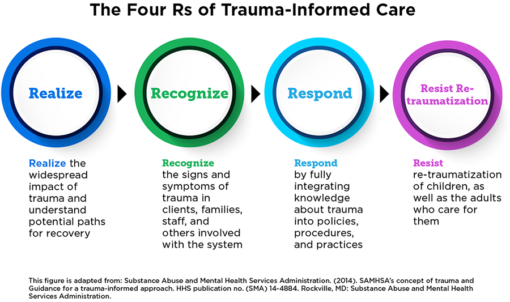A Framework for Funders
In early 2019, ten Boston-area funders eager to better understand how to reverse the impacts of trauma on healthy development joined the GMA Funder Community’s Trauma and Resilience Fund, a pooled giving and immersive learning experience. With the fund’s conclusion, we announce the surprise grants, outline key research and resources, and offer two essential frameworks for trauma-informed grantmaking.
Why Trauma Matters to Community Organizations and Grantmakers
The science of trauma is changing our understanding of how to design community-based programs and systems that best help the people they are supposed to serve. We spoke with experts in the field to identify the key concepts that could radically boost child-serving programs’ outcomes and reshape grantmakers’ funding decisions.
Every day, families, schools, and communities grapple with the negative and long-lasting effects of trauma and toxic stress on the healthy development of children. Left untreated, children exposed to multiple adverse childhood experiences (ACEs) may experience overwhelming feelings of fear, horror, and helplessness, and develop negative coping mechanisms, often seen as high risk and disruptive behavior. Additionally, they are at risk of developing physical and mental illness later in life.
Despite the prevalence of adversity, opportunity exists. Brain research showing the damaging, long-lasting effects of persistent trauma and toxic stress on children also points to the power of strong relationships and resilience in restoring healthy lives. One positive, supportive adult relationship in a child’s life is transformative.
Nonprofit organizations running programs embedded in our communities are in a unique position to mitigate the effects of trauma on children and their families. The programs are increasingly adopting trauma-informed approaches that have shown results. Change in these organizations, though, depends on extensive training, focused leadership, and a cultural shift. Grantmakers eager to support their capacity-building might be interested in the assessment framework outlined here.
Research, Resources, and Frameworks for Funders
Research on Trauma and Resilience

Extensive research, beginning with the landmark CDC-Kaiser Permanente Adverse Childhood Experiences (ACE) Study conducted from 1995 to 1997, demonstrates the lasting effects of childhood trauma into later life.
In a paper published in 2005, Excessive Stress Disrupts the Architecture of the Developing Brain, the National Scientific Council on the Developing Child exposed toxic stress as the link between ACES, neurology, and poor adult outcomes.
More recent research shows the possibility of actually reversing the damaging effects of trauma when young people enjoy supportive, stable adult relationships. The development of resilience is essential. Learn more about the science of resilience from Harvard’s Center for the Developing Child.
Resources Aimed at the Epidemic
Tens of millions of children in the United States are exposed to multiple adverse childhood experiences although some are disproportionately affected. Society’s response has to be comprehensive, with focus at the national, state, and city levels.
The National Child Traumatic Stress Network (NCTSN), working with hospitals and community-based organizations across the country, develops resources and training, much of it tailored to groups most likely to struggle—children in families affected by substance abuse, economic stress, or military life; LGBTQ youth, unaccompanied migrant youth, and youth experiencing homelessness. NCTSN pays particular attention to the professionals doing this work, as they may be affected by secondary traumatic stress. Visit NCTSN’s website for specialized resources, training, and frameworks.
This year the governor of California appointed the state’s first Surgeon General, Dr. Nadine Burke Harris, a long-time advocate for addressing traumatic stress in childhood, to prioritize the health and well-being of California’s young families. Dr. Burke Harris envisions a system where children are screened for ACES and those with high scores have access to services that help them build resilience and thrive. In a recent Q&A, California’s first-ever surgeon general outlines her plans to tackle toxic stress in children.
The City of Boston has invested heavily in the Public Health Commission’s network of Boston Neighborhood Trauma Teams, which offer support to all residents who feel impacted by community violence. Mayor Martin J. Walsh sees hope in “breaking the cycle of suffering.” Systemic change of this magnitude is difficult, requiring shifts in culture, policies, and practices.
What does it mean to be trauma-informed?
Awareness, commitment, and leadership are essential to becoming trauma-informed, to moving towards SAMSHA’s comprehensive approach—where all adults in a program or system “Realize, Recognize, Respond, and Resist Re-traumatization.”

Read about this in How to Implement Trauma-Informed Care to Build Resilience to Childhood Trauma.
Note: We use the term trauma-informed, recognizing the value of the term trauma-sensitive. Notably, Mass Advocates for Children has been leading a robust effort since the mid-90s to advocate for and create trauma-sensitive schools.
Frameworks for trauma-informed grantmaking
By adopting a trauma lens, funders can support a societal shift in thinking about people’s experiences. How do organizations acknowledge and respond to the adverse impacts of trauma in the people they serve and employ? We have developed a simple framework to guide discussions with prospective grant recipients.
The GMA Funder Community’s framework outlines approaches and ideas that contribute to more holistic programs and systemic change. The goal is to equip organizations to effectively support children and adults in overcoming barriers to resilience.
Download: Funder Guide: Trauma-Informed Grantmaking
Additionally, this NCTSN framework is indispensable in evaluating trauma-sensitivity in programs serving children and families.
Download: What is a Trauma-Informed Child and Family Service System?
Fund Awards to Organizations Leading Change
Increasingly, schools, mental health centers, health-care providers, and community organizations are incorporating a trauma lens to their programs. In 2019, funders eager to better understand the issue joined the GMA Funder Community’s Trauma and Resilience Fund, a pooled giving and immersive learning experience. The design of the Fund was informed by the work of the Lookout Foundation, which has played a catalytic role in supporting the field of complex trauma.
Experts doing ground-breaking work in the field provided invaluable information and perspective. They include: Margaret Blaustein, Ph.D., Director of the Center for Trauma Training, Inc. and a developer of the ARC treatment framework; Hilary Hodgdon, Ph.D., Director of Research Operations, The Trauma Center at JRI; Catherine Fine, MPH, Director, Boston Public Health Commission, Division of Violence Prevention; Jessica L. Griffin, Psy.D., Executive Director, Child Trauma Training Center at the University of Massachusetts Medical School, Department of Psychiatry.
The Trauma and Resilience Fund concluded by recognizing four Boston-area nonprofits for their exemplary work in addressing childhood trauma. These organizations have developed innovative methods of building resilience in youth to reverse the effects of adverse experiences and are building trauma-sensitive communities that support all young people.
The unexpected and unrestricted grants were awarded to Fathers’ Uplift, College Bound Dorchester, Silver Lining Mentoring, and Massachusetts Advocates for Children’s Trauma and Learning Policy Initiative. Models for building supportive, stable adult relationships, these programs offer the hope of stronger children and communities.
Adopting a Trauma Lens in Grantmaking
Clearly, there is no quick fix to the problem of adverse childhood experiences. We share this outline of frameworks, research, and resources to encourage incorporating a trauma lens in grantmaking. Gradually adopt this lens and participate in long-term systemic change.
In that spirit, here are two recent articles from the field. We hope you will share helpful resources with us as well.
- Positive Childhood Experiences May Buffer Against Health Effects of Adverse Ones, with researcher Christina Bethel, Johns Hopkins Bloomberg School of Public Health; NPR’s All Things Considered, 9/9/19.
- A Trauma Lens for Systems Change, by Patsy Carter and Andrea Blanch, Stanford Social Innovation Review, Summer 2019 (subscription content).
About Us
The GMA Funder Community promises a great experience in breaking out of traditional giving models. We aim to tap into the potential we see in groups of individual funders with overlapping missions and goals. To discuss adopting a trauma lens in your grantmaking, contact Danielle Belanger, program manager of the Trauma and Resilience Fund.
